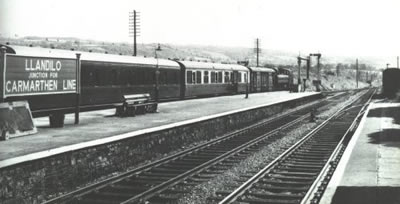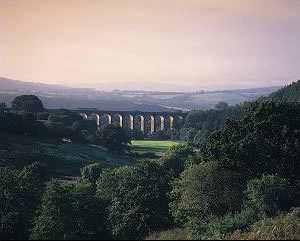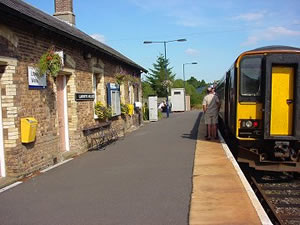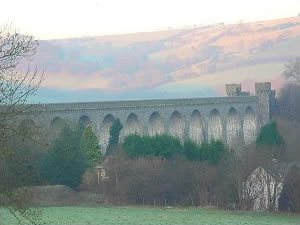Heart of Wales Railway
Introduction
Llandeilo is a fortunate little in town in many ways: fortunate in its location overlooking the lovely Tywi valley and its rich farming acres; fortunate in the unspoiled moorlands of the lonely Black Mountain that are just a short drive - or walk - away; and fortunate in the town's equally unspoiled architecture, much of it dating from the town's Georgian and Victorian past. But there's another reason to celebrate Llandeilo, too, and that's because it still has a railway line serving the town, something not many rural areas can claim any more in our car-obsessed society. And not just any railway either, but the wonderful Heart of Wales line, snaking 120 miles from Swansea to Shrewsbury through some of the prettiest countryside you'll ever find in Britain.
 Llandeilo railway station 1959.
Llandeilo railway station 1959.
Photo: locomotive 9645 waits to depart at 3:25 for Carmarthen. (Photo taken 29th August 1959.)
Llandilo (that's how Llandeilo was once spelled) used to be a junction for two lines: the Swansea to Shrewsbury line and the Llandeilo to Carmarthen line which had originally been opened by the Llanelly Railway Company in 1865. This line crossed the river Towy and then swung west to run south of the river to Carmarthen, stopping at Llandilo Bridge, Golden Grove, Drysllwyn, Llanarthney Halt, Nantgaredig, Abergwili, Abergwili Junction and Carmarthen.
There were three platforms at Llandilo station – numbers one and two serving the up and down lines on the Swansea to Shrewsbury route, and the third was for the Carmarthen branch, until this line was closed completely in 1963.
The Swansea to Shrewsbury service (originally known as the Central Wales Line) is still operating as the Heart of Wales Line. The change of name was for marketing purposes and has no real operational significance.
The following guide was written in 1996 for a tourist brochure and outlines both the history of the line and the major sights and scenery you can see just a window's thickness away from your seat.
Heart of Wales Travel Guide
By Audrey Doughty
All Aboard
For many people, a journey by train is simply a means of getting from A to B. Something to be endured rather than enjoyed, a chaotic commuter crush or elbowing one's way onto an Intercity.
There is an alternative. It is called the Heart of Wales Line which will get you from A to B, of course, as any sensible railway should, but it also offers you the chance to take a cruise by train with ports of call where a few hours or days can be spent. It is peaceful arid unhurried. Above all it runs through some of the most spectacular and beautiful scenery in Britain.
As the name suggests, the railway cuts through the Heart of Wales, commencing in the south at Swansea, and covers some one hundred and twenty miles to the northern terminus of Shrewsbury. Whatever your idea of Wales - beaches, mountains, rivers, streams, sheep, castles, coal-mining, weaving, music - you are likely to find it by using this line. It is full of contrasts.
At Swansea there is access to the beautiful Gower Peninsula and as the train heads north through South Wales there are echoes of the great industrial heritage of the valleys with glimpses of mining areas and towns whose general architecture and aspect reflect their past.
In Mid-Wales the train runs through peaceful undulating meadows, passing the attractive market towns of Llandeilo, perched above the station, and Llandovery. It then climbs into the mountains to an altitude of 820 ft above sea level affording breathtaking views. Throughout its journey the train crosses viaducts and plunges into tunnels. There are hills and valleys; rivers and streams. The spa towns of Mid-Wales invite further contrast. Llandrindod Wells is the largest and, with its grand red brick Victorian buildings, is set somewhat incongruously against the rolling hills and farmsteads which surround it.
There are sheep almost everywhere, on and off the line and in the case of the former, if a few sharp blasts on the hooter don't do the trick, the guard and driver have to get down and persuade them to move. Not always an easy job.
The wild border country around Knighton and Offa's Dyke, where Wales meets England, gives way to lush meadows and the Shropshire hills. The railway's northern terminus is the ancient town of Shrewsbury, which, with its wealth of black and white timbered buildings and narrow passageways, is a world apart from the modern city of Swansea at the other end of the line.
This guide has been compiled to enable visitors to take full advantage of this beautiful and scenic route. There are plenty of places to explore along the line, as well as off it. Many places can be reached by service or post buses, of which some of the routes have been selected for mention. Using the information supplied in this guide, you can spend days or weeks in peaceful pottering without the stress of sitting behind the wheel. Leave it to the train driver and relax. He knows the way and the day has yet to dawn when a sheep on the track causes a tailback.
A History of the Line
The major part of the Heart of Wales Line is now single track, the exceptions being between Craven Arms and Shrewsbury and a few short sections in the south between Llanelli and Swansea. Trains can pass at Llandeilo, Llandovery, Llanwrtyd, Llandrindod and Knighton and when you see the driver get out at these points, he is not telephoning his wife, but the signal box at Pantyffynnon from where the supervising signalman authorises him to remove a token from the little hut on the platform, thus enabling the train to proceed safely through the next section.
In times past, it was much more interesting, with signal boxes and 'proper' old fashioned semaphore signals all along the line and train crews collecting a wooden or metal staff or a ticket from the signalman (often while the train was in motion) before being allowed into the next section.
With the cut-backs in 1964, alas, all that changed. Most of the signal boxes were taken out of use, some sold, some demolished and one at Llandrindod retained as a museum. Nowadays, the good old semaphore signals can be seen at Pantyffynnon (where the GWR box built in 1892 is still working) and Craven Arms.
Relax and enjoy the journey with this Armchair Guide
Swansea to Ammanford
Leaving Swansea, passing the Landore Locomotive Depot on the right, the train soon begins to climb and to enter the 789 yard Cockett tunnel. Nearly a hundred years ago, on the 19th June 1899, its roof caved in because of mining operations underneath. After the little halt at Gowerton which, though once important, now belongs to the 'don't blink or you'll miss it' category, the train crosses the viaduct over the broad estuary of the River Loughor, giving the opportunity of a left backward glance at Penclawdd, the village famous for its cockles which nestles on the north coast of the Gower Peninsula. The next town to come into view is Llanelli, industrial in aspect with strong links with the tinplate industry. It was at Llanelli docks that the Llanelly Railway Company began to build the southern section of the line which, over a hundred years ago, when joined with four other railways, became the Heart of Wales Line.
Don't jump out as you leave Llanelli; you are still on the right train. It is simply reversing to get back to the junction and to leave the main line. A large tinplate works appears on the right and soon there is marshland. Between Llanelli and Llandeilo there are seven halts. They were all once stations, complete with sidings, station master and signal boxes. The tiny halts of Bynea and Llangennech are followed by more splendid views across the estuary, another tunnel, then over the Loughor again into Pontarddulais. Try to picture a busy station which opened in 1839 and subsequently had four platforms. Alas by 1965, it had declined and, as if to add insult to injury, when a visitor asked one of the locals the way to the station in the 1980s, he was told that it had closed 'years ago'. How the mighty have fallen!
The River Amman soon appears to join the Loughor and on the right is the 1892 Pantyffynnon signal box which still controls the single track all the way up to Craven Arms nearly eighty miles north. As the train approaches the station, you will see another line running off to the right; a remnant of the last of the heady days of coal traffic. It runs to an anthracite coal washery at Gwaun-cae-Gurwen (mercifully known as GCG) and is now only 6.5 miles long; a mere ghost of the busy Brynamman branch of which it was once a part. This area had a lot of coal branches.
Ammanford to Llandovery
After Ammanford, the anthracite belt is replaced by pastureland. Llandybie halt was adopted by the local primary school in 1989. Once past Llandybie, look left approaching Cilyrychen crossing over the A483, and you will see the gloomy Cilyrychen Lime Kilns. The site is now owned by the Alfred McAlpine Company who keep a diesel storage tank on top of one of them. The Lime Quarries were once served by the line and a story is told of a tramp who, seeking a warm place for the night, slept on top of one of the kilns and was found dead the next morning, killed by the fumes. The train climbs and then descends to Ffairfach, which once had a creamery with milk sidings, and proceeds to Llandeilo.
You have to crane your neck to look at Llandeilo perched high above the station. In the good old days there was a refreshment room and bar at the station and staff brought a tea urn onto the train and supplied footmuffs!
Next comes a straight section of track through Talley Road and Glanrhyd (these stations are now closed) and over Glanrhyd Bridge. This was the scene of a tragic accident in October 1987 when the bridge collapsed in flood-water killing three passengers and the driver of the train crossing it. The present bridge was built in 1988.
An old milk siding at Llangadog is an echo of former days when there was a large creamery here. Next the train crosses the River Tywi viaduct and on to Llanwrda. Try to imagine 10,000 tons of goods being handled here, for this is what the records of 1923 show. Over Llwynjack bridge lies the busy little market town of Llandovery.
Llandovery to Sugar Loaf
 Cynghordy viaduct
Cynghordy viaductCourtesy:
From this point begins the journey into the mountains. Make sure you are sitting on the right-hand side and get your camera ready. First the route curves through woodlands and then climbs to the little halt of Cynghordy. The not very attractive looking shelter is, amazing though it may seem, a vintage object of 1892. It does appear to have been rather unimaginatively patched up and someone seems to have had a lot of blue paint to spare! There is a nice tale from Cynghordy concerning a goat due to be despatched to Scotland to mate. Unfortunately, the station-master couldn't sort out the paper work to deal with the consignment, so he tethered the animal underneath the signal box. She was duly collected by her owner, a couple of weeks later, who must have wondered why the trip had been so unfruitful. Watch out for Cynghordy viaduct which you will be crossing next, high over the River Brân. Ahead is Sugar Loaf Mountain, below is the Brân Valley and behind is a spectacular view over the western side of the Brecon Beacons and Black Mountain.

Courtesy: Heart of Wales Railway
A thousand yards of darkness follows as the train plunges into the Sugar Loaf tunnel. The climb to the Sugar Loaf summit is 1 in 60 and in the days of steam engines pulling heavy freight, was quite a challenge. Banking engines were housed at Llandovery to give the much-needed push from the rear. Look out for Sugar Loaf halt as you emerge from the tunnel. It was originally built for the railway workers who lived in cottages alongside the line. There is - and was - no village and the 'railway children' boarded the train to go to school at Llanwrtyd and the wives travelled to the Friday market at Llandovery.
Sugar Loaf to Llandrindod Wells

Courtesy: Sphaera
From Sugar Loaf, there is a descent to Llanwrtyd Wells, which is the smallest town in Britain, and was a fashionable spa in Victorian times. Llangammarch, another spa town, situated on the River Irfon is the next station. In 1912, the Kaiser and his family stayed here incognito, having registered as Prince and Princess Munster from Germany.
There follows Garth and then Cilmeri. On the left at Cilmeri, stands a monument marking the spot where, it is claimed, 'Prince Llewelyn the Last' was killed by English troops in 1282. More tunnels and bridges and Builth Road is reached. Below on the right, just before the station, can be glimpsed the Cambrian Arms which was once the station refreshment room for both the Heart of Wales Line and the Mid Wales Railway which crossed beneath it and was closed in 1962. There was quite a substantial railway community here and one of the terraces of railway workers cottages can be seen on the left as the trains pull out.
Leaving the Wye Valley, the route follows that of the River Irthon with fine views, to the left, of the pass through which the Wye flows from its source high up in Plynlimmon.
Passing a substantial residential caravan site situated near the village of Howey on the right, the train continues alongside the A483 to Llandrindod Wells which was once a popular spa. In the late 19th century 80,000 visitors a year came to take the waters. The Pump Room is still intact, as are the waters but European regulations are currently preventing their consumption. Look out at the large Victorian buildings on the right as the line crosses the top of the wooded Rock Park and the Pump Room is down a steep incline on the left but well hidden by trees.
On the right-hand platform of Llandrindod station there is a commemorative slab marking the spot where the Queen first stepped onto Welsh soil in 1952. A plaque on the wall marks the station's 'Re-Victorianisation' which took place during the annual Llandrindod Victorian Festival in 1990. This included affixing a red Victorian Post Box to the station wall, which is clearly visible on the left. It was brought from Machynlleth, a town about fifty miles away. What inducements were offered to persuade them to part with it are not clear.
As the train leaves, ignore the first small and not very inspiring industrial estate (are they ever?) on your left and see if you can spot the Middleton Inn situated on the A483 on the other side. There is a 'pinch of salt' tale told about how this became an inn. During construction of the line, Irish navvies working at the northern end of the town thought it too far to walk to the Llanerch Inn and decided to convert the Middleton, then a private house, into a public one. As the place wasn't very large, two downstairs rooms had to be knocked into one. The gang cut off ten feet of rail and used it as a lintel. The bosses couldn't understand what had happened to the length of rail and, plastered up, it was safely hidden. The truth was never discovered and the navvies had their watering hole.
Llandrindod Wells to Knighton
A short while after leaving Llandrindod, there is a glimpse of the Radnor Forest high on the right. Be ready to look out on the left as the train goes through the next halt of Pen-y-bont. On the platform there are four large concrete flower containers each bearing a word. 'Safety', 'Speed', 'Comfort', 'Efficiency'. Between them is a slab bearing the well known verse:
The kiss of the sun for a pardon
The song of the birds for mirth
One is nearer God's heart in a garden
Than anywhere else on earth
The gardens at this station were once very fine. Alas, no longer, but one doubts if the good folk of Pen-y-bont are any farther from heaven for all that.
After the Pen-y-bont tunnel, the route follows a wild common but prepare to admire all the charms of Dolau Halt on the right. It wins so many prizes that most people have lost count. A local action group looks after it. Within sight of the River Aran for a while, the train climbs up to 'Llanbister Road'. There is no village here, just a remote halt 848 ft above sea level.

Courtesy: Sphaera
There is a descent into Llangunllo before climbing to the summit of the line (980 ft), through the tunnel and down again. Look right at the strange conical hill and little Heyope church below. Knucklas, next, was once quite important. It was a Radnor Borough which entitled it to a Member of Parliament. Curving left, comes the Knucklas Viaduct with its ornate turreting at each end. In 1925, a fox, pursued by hounds, made for the viaduct and, on encountering a gang of workmen coming in the opposite direction, jumped the 69 ft to its death. The word 'fox' was scored into a lintel at the point where it jumped.
The line now follows the River Teme and with Offa's Dyke on the left, arrives at Knighton. The station is actually situated in England but as you will see from the signs, the town it serves is in Wales. The Welsh name for Knighton is 'Trefyclawdd', which means the ‘town on the embankment'.
With the River Teme on the right, you leave Wales behind and go on to Bucknell and Hopton Heath. Lush meadows and the River Clun accompany you to Broome. Look to the right as the train approaches the next station of Craven Arms and you will see the 13th century Stokesay castle, a superb example of a fortified manor house. In its heyday, Craven Arms station was a busy agricultural centre.
It is double track from now on and if you look behind to the right, you will see the main Manchester to Cardiff line, which the train is about to join. More hills come into view. The Long Mynd sits high (nearly 1700 ft) above Church Stretton on the left and on the right, as the train pulls out, towers Caer Caradoc. The landscape flattens out but far away on the right can be seen The Wrekin, a distinctively shaped hill 1,335 ft in height and a well known landmark in Shropshire.
As the train enters Shrewsbury, look out for the Abbey on the right and for the old London North Western Railway signal box sitting solidly in a triangle of track just outside the station. It is the Severn Bridge Junction Box, still in use and is a listed building. Look left and upwards as the train pulls in and you will see the castle walls of the ancient town of Shrewsbury waiting to welcome you.
Notes
This guide was written by Audrey Doughty who is a seasoned traveller on the Heart of Wales Line. She has also worked in tourism in mid Wales. Please note that the opinions expressed in the text are those of the author and any recommendations made are not meant to imply that other establishments or organisations are less worthy. It was written in 1996 and some of the details may have changed since that date.
Latest details of the Heart of Wales line, including up-to-date timetable, can be found on the Heart of Wales website
Please note: The train has no refreshment service so if you're making the full four hour journey from Swansea to Shrewsbury (or Shrewsbury to Swansea) remember to bring your own refreshments.